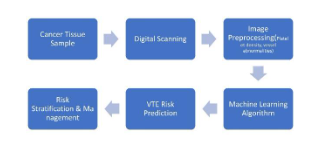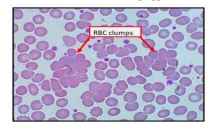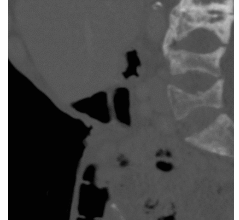
Keywords: Tumor-associated-thrombosis, venous thromboembolism, digital pathology, artificial intelligence, machine learning, computational histopathology, predictive modeling, Khorana score, thrombosis biomarkers.
Background: In cancer patients, venous thromboembolism (VTE) and cancer-associated thrombosis (CAT) continue to be the main causes of morbidity and death. The prediction of CAT is frequently inaccurate even with well-established clinical models like the Khorana score, underscoring the need for more reliable and customized instruments. New possibilities for risk classification and early CAT prediction have been made possible by recent developments in digital pathology and artificial intelligence (AI). Quantitative examination of tumor histology, including platelet infiltration, immune cell profiles, and thrombogenic microenvironmental characteristics, is made possible by AI-powered computational pathology. Deep learning and gradient boosting models are two examples of machine learning algorithms that have outperformed conventional techniques in terms of CAT prediction accuracy. Furthermore, new biomarkers linked to the risk of thrombosis have been identified through the integration of genomic and transcriptomic data and AI-driven analysis of histological images.
A revolutionary method for comprehending the tumor-thrombosis interaction is provided by this developing collaboration between AI and digital pathology, opening the door to precision medicine approaches for thromboprophylaxis. However, for clinical translation, issues including interpretability, data standards, and ethical considerations need to be resolved. The potential, existing uses, and future directions of AI-integrated digital pathology in predicting tumor-associated thrombosis are examined in this presentation.
Digital Formats: Any image file format that can be imported into this file will be acceptable for publication; to avoid technical problems, we suggest using PNG/JPEG format and mention Fig number with short detail.

Figure 1: Workflow for Predicting Cancer-Associated Venous Thromboembolism (VTE) Using Machine Learning.


References: [1] Norbaini Binti Abdol Razak N. et al. (2018) Cancers (Basel), 10(10), 380. [2] Fernandes C. J. et al. (2019) Clinics (Sao Paulo), 74, e1409. [3] Kim Y. J. et al. (2020) Blood Res., 55(1), S31–S35. [4] Pruemer J. M. (2005) Am. J. Health Syst. Pharm., 62(22 Suppl 5), S4–S10. [5] Noble S. and Pasi J. (2010) Br. J. Cancer, 102(Suppl 1), S17–S21. [6] Falanga A. and Marchetti M. (2023) Blood Rev., 60, 101090. [7] Ahn J. et al. (2023) Sci. Rep., 13, 10148. [8] Kuderer N. M. and Lyman G. H. (2024) JCO Clin. Cancer Inform., 8, e2300204. [9] Patell R. et al. (2024) Res. Pract. Thromb. Haemost., 8(2), 100089. [10] Reyes Gil M. et al. (2024) Thromb. Res., 236, 122–127. [11] Li H. et al. (2024) Eur. Radiol., 34, 1123–1133. [12] Khorana A. A. and Francis C. W. (2018) Hematology Am. Soc. Hematol. Educ. Program, 2018(1), 147–155. [13] Ünlü B. and Versteeg H. H. (2018) Semin. Thromb. Hemost., 44(3), 199–210. [14] Buijs H. E. A. and Versteeg H. H. (2020) Br. J. Haematol., 189(4), 637–649. [15] Ay C. et al. (2011) Blood, 117(3), 804–810.
[16] Khorana A. A. et al. (2008) Blood, 111(10), 4902–4907. [17] El-Sherbini A. M. et al. (2024) J. Thromb. Haemost.,
22(1), 80–90. [18] Sharma A. et al. (2019) Thromb. Res., 177, 123–131. [19] Donati M. B. (1995) Haemostasis, 25(3), 137–143. [20] Fu Y. et al. (2019) Nat. Commun., 10, 5642. [21] Fuchs T. A. et al. (2012) Proc. Natl. Acad. Sci. U.S.A., 109(32), 13076–13081. [22] Zhou Y. et al. (2021) Front. Oncol., 11, 712835. [23] Abdol Razak N. B. et al. (2017) Int. J. Mol. Sci., 18(9), 1935. [24] Cedervall J. and Olsson A.-K. (2016) Thromb. Res., 140(Suppl 1), S36–S41. [25] McCaffrey E. F. et al. (2024) Nat. Commun., 15, 1093. [26] Baxi V. et al. (2021) J. Pathol., 254(5), 580–594.
Biography: Adithi P Shankar, is a fourth-year medical student at Manipal University College, Malaysia, with a strong interest in Internal Medicine, Haematology and Oncology. I have presented two research papers at international conferences, winning 2nd and 3rd prizes for my work. I am actively seeking further research opportunities and I am passionate about academic growth. My areas of interest include clinical research, evidence-based medicine, oncology, and improving patient outcomes through innovation and critical inquiry.
#DigitalPathology #ArtificialIntelligence #AIinHealthcare #TumorBiology #CancerResearch #Thrombosis #OncologyResearch #PathologyInnovation #PrecisionMedicine #MedicalAI #AIPathology
#ComputationalPathology #CancerDiagnostics #TumorBiomarkers #CancerAI #MedicalResearch #DigitalHealth #HealthcareInnovation #PathologyResearch #ClinicalOncology #AIinOncology #CancerTreatment #CancerDetection #MolecularPathology #TranslationalMedicine #AIForHealthcare #Histopathology #CancerBiology #PredictiveAnalytics #MachineLearningInMedicine #AIinDiagnostics #MedicalImagingAI #PathologyAI #DigitalDiagnostics #OncologyAI #CancerManagement #AIinCancerResearch #MedicalTechnology #HealthcareAI #CancerPrediction #BiomedicalAI #PersonalizedMedicine #AIinClinicalResearch #DigitalOncology #TumorAnalysis #ThrombosisResearch #PathologyCommunity #MedicalInnovation #SmartHealthcare #FutureOfMedicine



